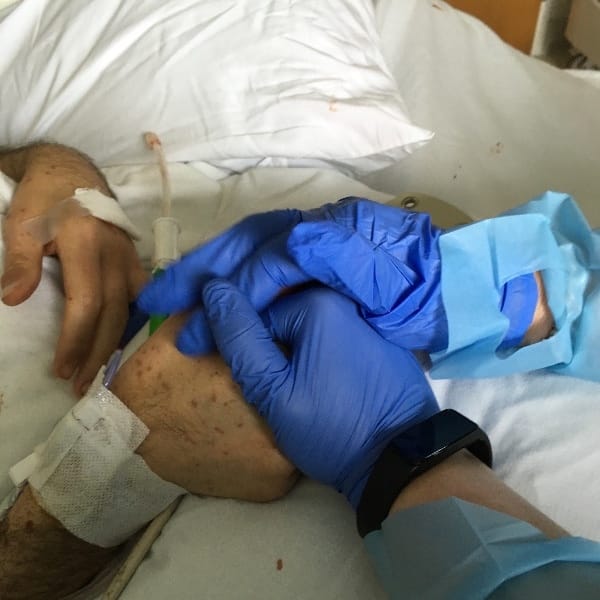This Man Suffered From A Rare Syndrome That Burns You From The Inside Out, All Because He Had A Reaction To His Anti Depressants
*Warning: Graphic images ahead*
A man’s reaction to anti depressants was so bad, his skin started peeling off his face. The kin on his entire body flaked off, leaving his flesh exposed and at risk of infection. He was diagnosed with a rare syndrome caused by medication that targeted his bi-polar disorder.
Jonathan Laird, from Greenfield, Indiana, was prescribed lamotrigine in April 2016 to boost his mood after being diagnosed with bipolar disorder.
Within a month of taking the pills, the 38-year-old was suffering flu-like symptoms and his eyes became so sore it felt as through ‘glass was piercing them’.
Laird was diagnosed with Stevens-Johnson syndrome.
The symptoms escalated quickly, and he developed red raw sores inside his mouth and lips, as well as on the back of his throat and across his entire body.
Mr Laird was taken to a hospital and was immediately transferred to an intensive care unit where he was diagnosed with Stevens-Johnson syndrome (SJS).
Stevens-Johnson syndrome is a rare but serious disorder that affects the skin, mucous membrane, genitals and eyes. The mucous membrane is the soft layer of tissue that lines the digestive system from the mouth to the anus, as well as the genital tract (reproductive organs) and eyeballs. Stevens-Johnson syndrome is usually caused by an unpredictable adverse reaction to certain medications. It can also sometimes be caused by an infection —and in Laird’s case, it was a reaction to Lamotrigine.
The syndrome often begins with flu-like symptoms, followed by a red or purple rash that spreads and forms blisters.
The affected skin eventually dies and peels off. Stevens-Johnson syndrome is a medical emergency that requires treatment in hospital, often in intensive care or a burns unit.
The skin on Mr Laird’s face started rotting and flaking off, leaving his flesh exposed and prone to infection.

Doctors wrapped his face in pig skin grafts, which keep affected wounds sterile before a proper skin graft can be done. They have long been used as a wound dressing in burned patients.
When Mr Laird was admitted to hospital, doctors scrambled to save as much of his healthy skin as they could.
They even stitched his eyes shut for two weeks in a bid to protect his eyeballs because the disorder had made them ultra-sensitive to light. He recalled: ‘My eyes started to feel like they had little pieces of glass in them, it was very uncomfortable, and I was scared to touch them or rub them because it literally felt like I was going to cut my eyes. ‘I thought, “Is this Stevens Johnson Syndrome?”’
‘When you have Stevens Johnson Syndrome you basically burn from the inside out,’ said Jonathan.
‘It starts as a rash and then the rash erupts into blisters. ‘They stitched my eyes shut to protect my vision, they bound my hands together so I couldn’t rip the tube out that was down my throat. ‘I don’t remember much. I fell in and out of consciousness. ‘I felt like I was dreaming all the time, I don’t think I really knew that my eyes were stitched shut. ‘They also put pigskin all over me to prevent infection. ‘They were afraid I was going to get pneumonia at one point, so they had to make sure that everybody who came to see me had gloves on and gowns.’
Jonathan was unable to speak and had to communicate with his family by writing down answers to their questions.

He said at one point he wrote ‘am I going to die?’ which was hard for everyone to read. After 11 days in ICU, he was transferred to a burns unit and his eyes were unstitched after two weeks. Jonathan was released from the hospital last summer and continues to recover while writing a blog about the condition. He added his hope was to show that those affected by Stevens Johnson Syndrome are not alone. ‘Be brave and you’ll get through this, and the person you’re going to be on the other side of this is a much stronger person,’ he said.
Steven Johnson Syndrome(SJS) affects only one in a million people in the United States, with only 22,000 new cases each year.
The damage the syndrome causes in just a few short weeks can include(perhaps for the rest of your life) any of the following: Sores in mouth/throat/eyes/skin, several blisters, scars, shedding of skin and internal organs, chronic pain and fatigue, blindness and in some cases death. There is no way to stop the avalanche of these reactions and in the words of medical professionals “it needs to run its course through the body.” The treatment does include pain killers, antibiotics, anti-inflammatories, steroids, IV’s for hydration and food. SJS is aggressive, devastating and extremely painful for loved ones to witness.




